Business Strategy: Uber's Macro & Internal Environment Report
VerifiedAdded on 2022/12/28
|13
|4077
|317
Report
AI Summary
This report provides a comprehensive analysis of Uber's business strategy, examining the impact of the macro environment using PESTLE analysis and stakeholder analysis. It then delves into Uber's internal environment, applying the McKinsey 7-S model and VRIO framework to assess its capabilities and resources. The report further evaluates the competitive forces within Uber's market sector using Porter's Five Forces model. Finally, it applies various strategic planning concepts, models, and theories to interpret and devise Uber's strategic planning, culminating in a detailed understanding of Uber's strategic approach and recommendations for future development. The report covers various aspects like political, economic, social, technological, legal, and environmental factors and their influence on Uber's performance. It also explores the importance of valuable, rare, inimitable, and organized resources in determining the potential of an organization.
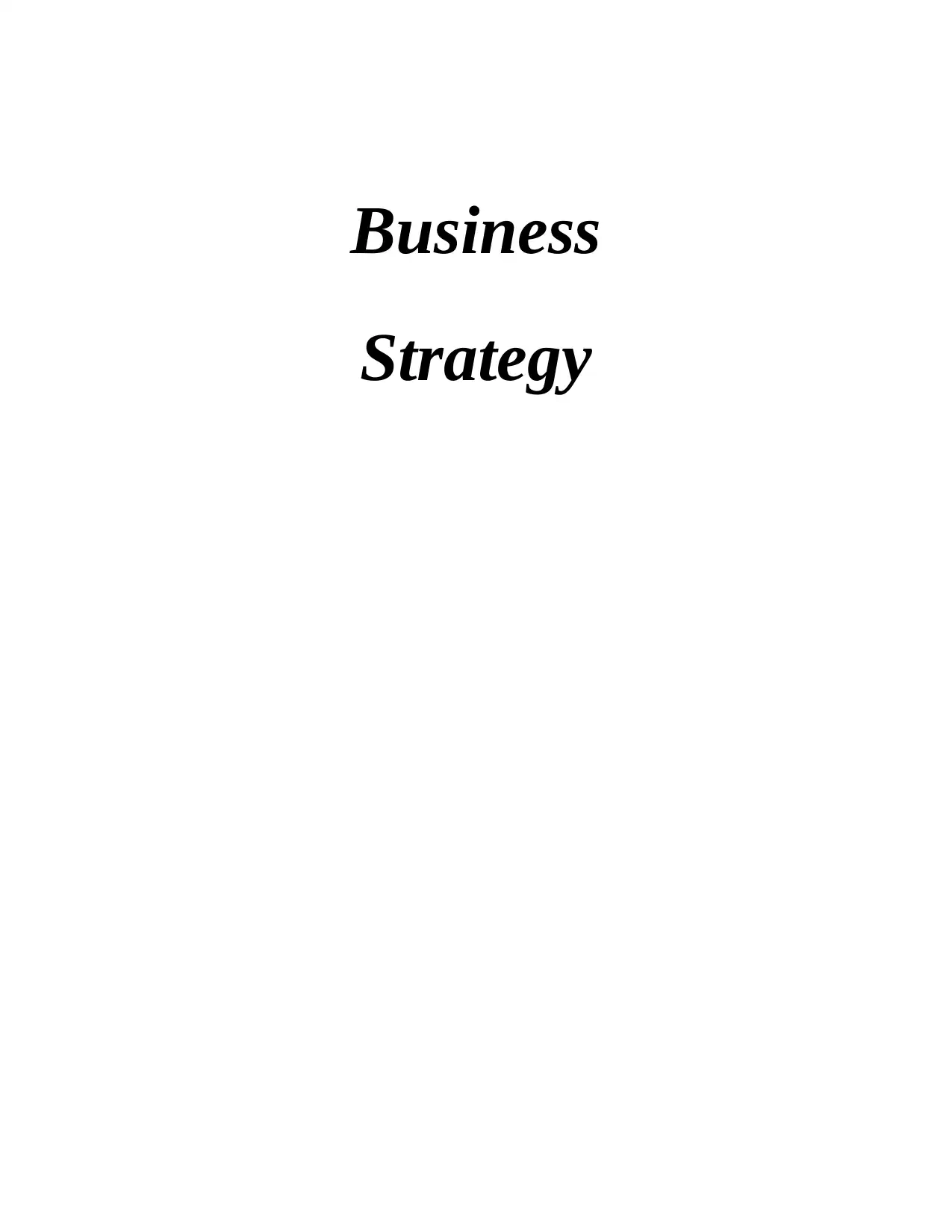
Business
Strategy
Strategy
Paraphrase This Document
Need a fresh take? Get an instant paraphrase of this document with our AI Paraphraser
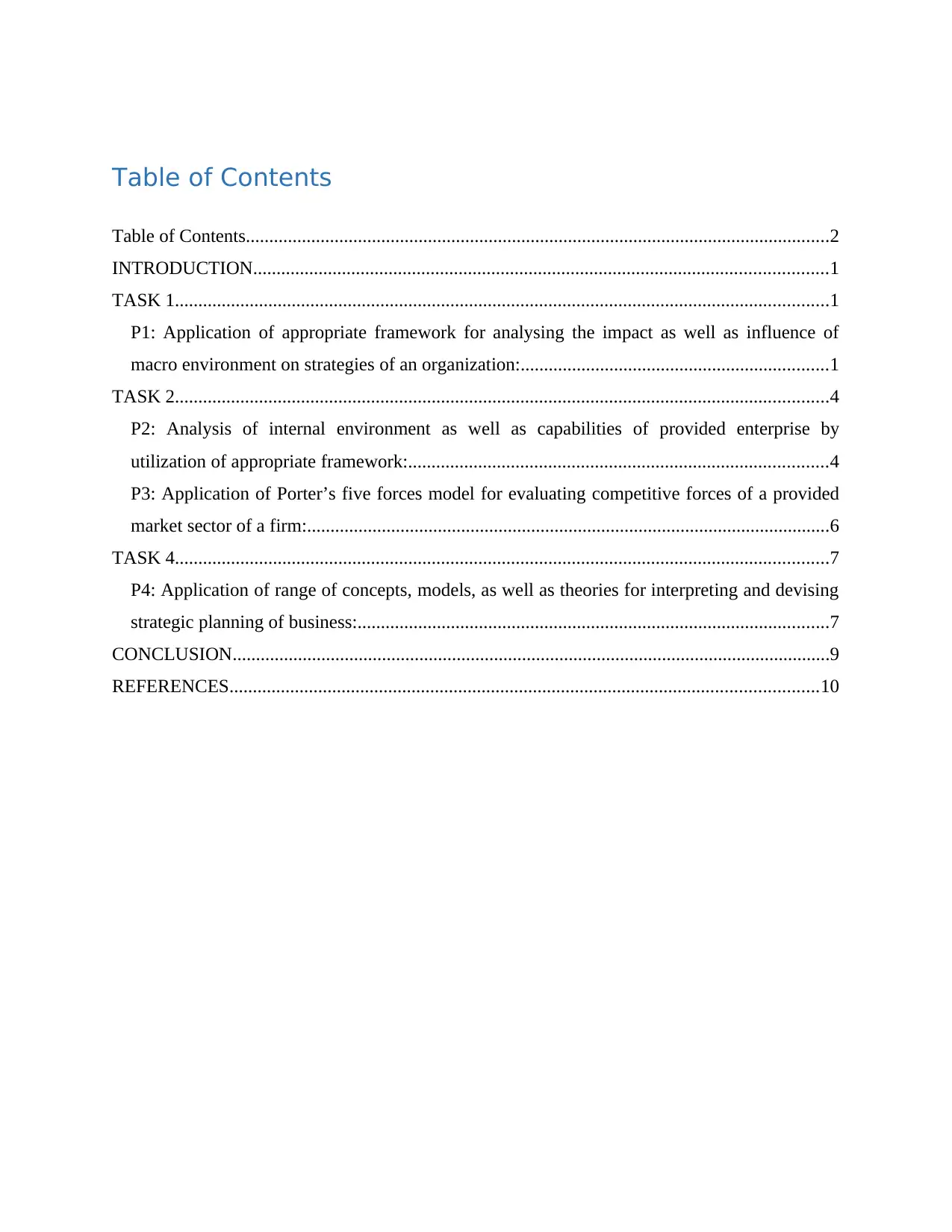
Table of Contents
Table of Contents.............................................................................................................................2
INTRODUCTION...........................................................................................................................1
TASK 1............................................................................................................................................1
P1: Application of appropriate framework for analysing the impact as well as influence of
macro environment on strategies of an organization:..................................................................1
TASK 2............................................................................................................................................4
P2: Analysis of internal environment as well as capabilities of provided enterprise by
utilization of appropriate framework:..........................................................................................4
P3: Application of Porter’s five forces model for evaluating competitive forces of a provided
market sector of a firm:................................................................................................................6
TASK 4............................................................................................................................................7
P4: Application of range of concepts, models, as well as theories for interpreting and devising
strategic planning of business:.....................................................................................................7
CONCLUSION................................................................................................................................9
REFERENCES..............................................................................................................................10
Table of Contents.............................................................................................................................2
INTRODUCTION...........................................................................................................................1
TASK 1............................................................................................................................................1
P1: Application of appropriate framework for analysing the impact as well as influence of
macro environment on strategies of an organization:..................................................................1
TASK 2............................................................................................................................................4
P2: Analysis of internal environment as well as capabilities of provided enterprise by
utilization of appropriate framework:..........................................................................................4
P3: Application of Porter’s five forces model for evaluating competitive forces of a provided
market sector of a firm:................................................................................................................6
TASK 4............................................................................................................................................7
P4: Application of range of concepts, models, as well as theories for interpreting and devising
strategic planning of business:.....................................................................................................7
CONCLUSION................................................................................................................................9
REFERENCES..............................................................................................................................10
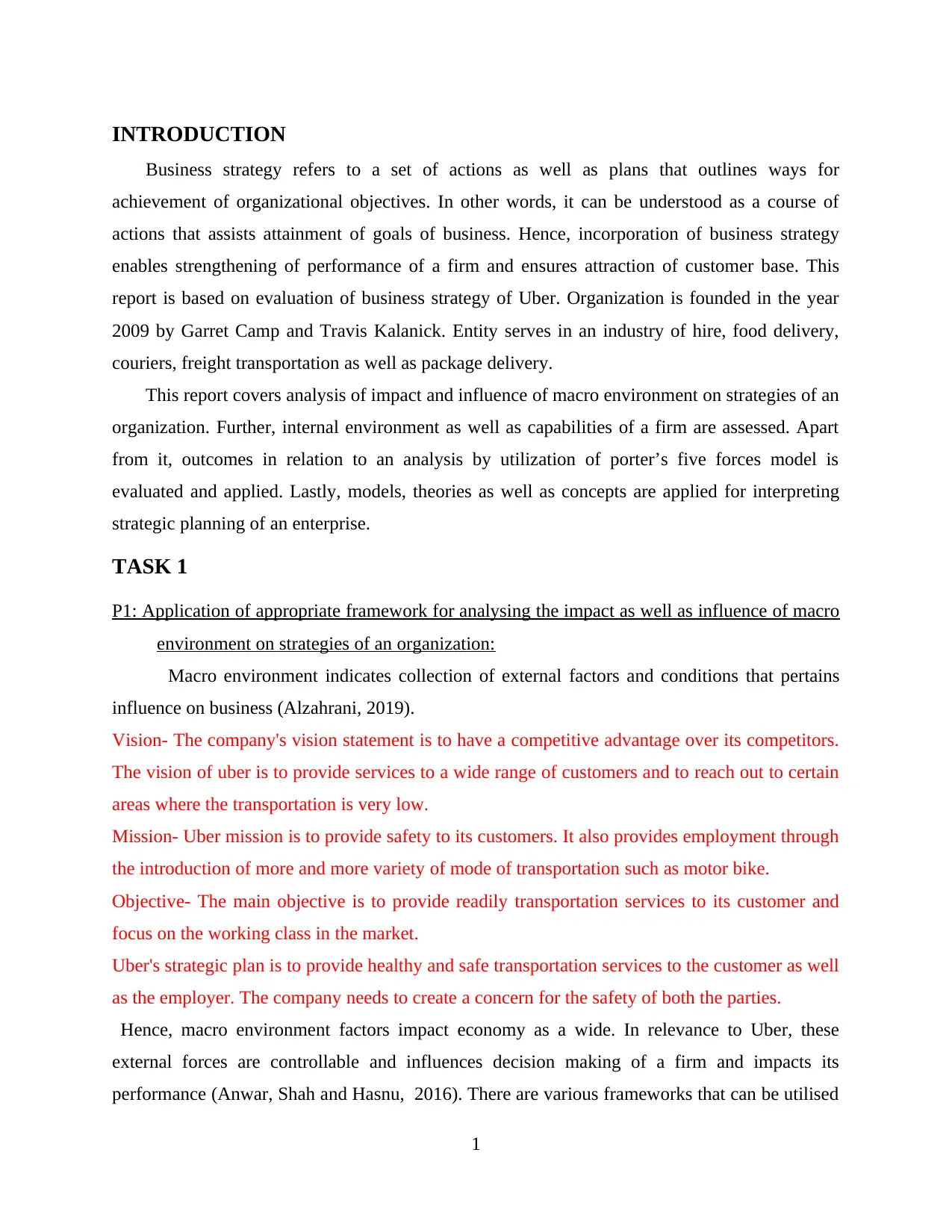
INTRODUCTION
Business strategy refers to a set of actions as well as plans that outlines ways for
achievement of organizational objectives. In other words, it can be understood as a course of
actions that assists attainment of goals of business. Hence, incorporation of business strategy
enables strengthening of performance of a firm and ensures attraction of customer base. This
report is based on evaluation of business strategy of Uber. Organization is founded in the year
2009 by Garret Camp and Travis Kalanick. Entity serves in an industry of hire, food delivery,
couriers, freight transportation as well as package delivery.
This report covers analysis of impact and influence of macro environment on strategies of an
organization. Further, internal environment as well as capabilities of a firm are assessed. Apart
from it, outcomes in relation to an analysis by utilization of porter’s five forces model is
evaluated and applied. Lastly, models, theories as well as concepts are applied for interpreting
strategic planning of an enterprise.
TASK 1
P1: Application of appropriate framework for analysing the impact as well as influence of macro
environment on strategies of an organization:
Macro environment indicates collection of external factors and conditions that pertains
influence on business (Alzahrani, 2019).
Vision- The company's vision statement is to have a competitive advantage over its competitors.
The vision of uber is to provide services to a wide range of customers and to reach out to certain
areas where the transportation is very low.
Mission- Uber mission is to provide safety to its customers. It also provides employment through
the introduction of more and more variety of mode of transportation such as motor bike.
Objective- The main objective is to provide readily transportation services to its customer and
focus on the working class in the market.
Uber's strategic plan is to provide healthy and safe transportation services to the customer as well
as the employer. The company needs to create a concern for the safety of both the parties.
Hence, macro environment factors impact economy as a wide. In relevance to Uber, these
external forces are controllable and influences decision making of a firm and impacts its
performance (Anwar, Shah and Hasnu, 2016). There are various frameworks that can be utilised
1
Business strategy refers to a set of actions as well as plans that outlines ways for
achievement of organizational objectives. In other words, it can be understood as a course of
actions that assists attainment of goals of business. Hence, incorporation of business strategy
enables strengthening of performance of a firm and ensures attraction of customer base. This
report is based on evaluation of business strategy of Uber. Organization is founded in the year
2009 by Garret Camp and Travis Kalanick. Entity serves in an industry of hire, food delivery,
couriers, freight transportation as well as package delivery.
This report covers analysis of impact and influence of macro environment on strategies of an
organization. Further, internal environment as well as capabilities of a firm are assessed. Apart
from it, outcomes in relation to an analysis by utilization of porter’s five forces model is
evaluated and applied. Lastly, models, theories as well as concepts are applied for interpreting
strategic planning of an enterprise.
TASK 1
P1: Application of appropriate framework for analysing the impact as well as influence of macro
environment on strategies of an organization:
Macro environment indicates collection of external factors and conditions that pertains
influence on business (Alzahrani, 2019).
Vision- The company's vision statement is to have a competitive advantage over its competitors.
The vision of uber is to provide services to a wide range of customers and to reach out to certain
areas where the transportation is very low.
Mission- Uber mission is to provide safety to its customers. It also provides employment through
the introduction of more and more variety of mode of transportation such as motor bike.
Objective- The main objective is to provide readily transportation services to its customer and
focus on the working class in the market.
Uber's strategic plan is to provide healthy and safe transportation services to the customer as well
as the employer. The company needs to create a concern for the safety of both the parties.
Hence, macro environment factors impact economy as a wide. In relevance to Uber, these
external forces are controllable and influences decision making of a firm and impacts its
performance (Anwar, Shah and Hasnu, 2016). There are various frameworks that can be utilised
1
⊘ This is a preview!⊘
Do you want full access?
Subscribe today to unlock all pages.

Trusted by 1+ million students worldwide
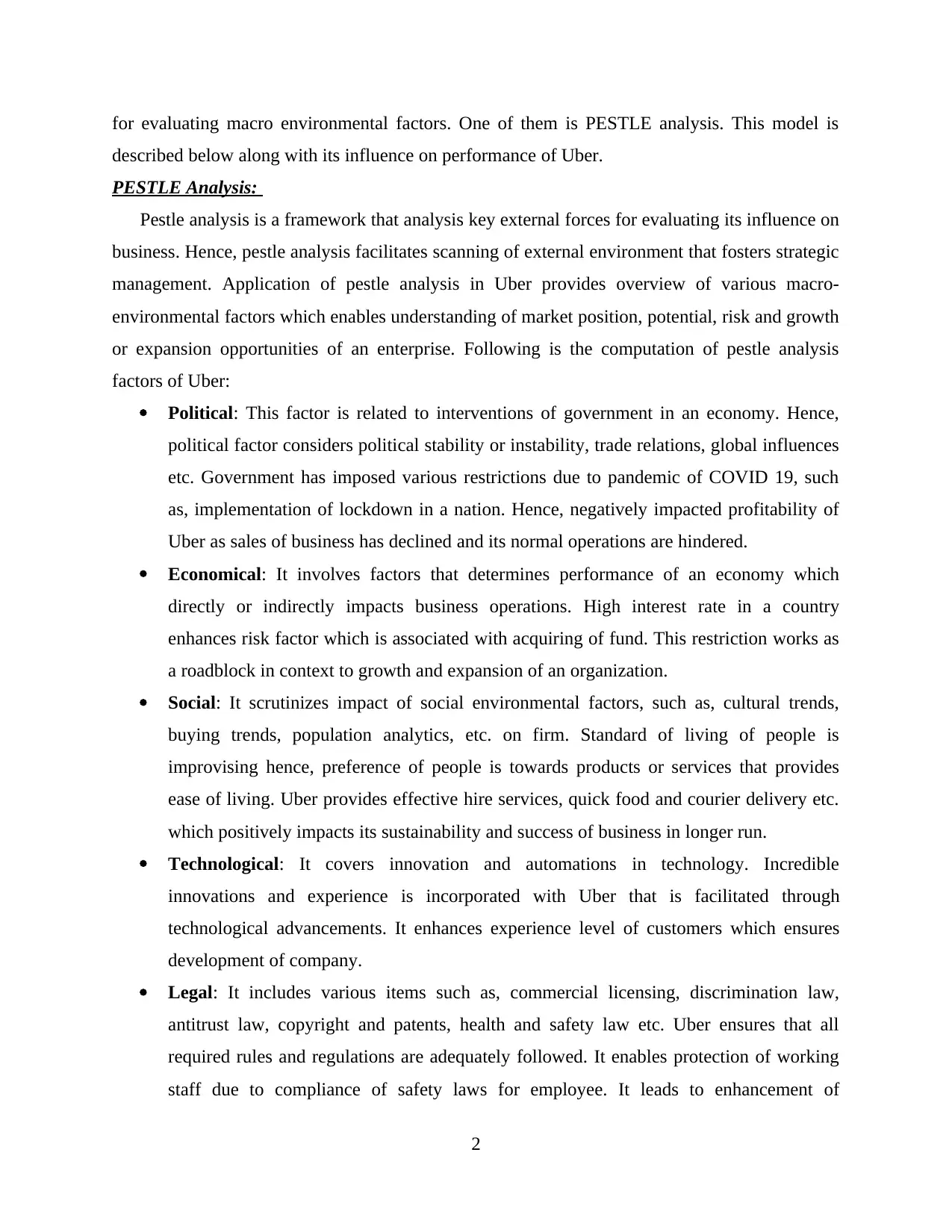
for evaluating macro environmental factors. One of them is PESTLE analysis. This model is
described below along with its influence on performance of Uber.
PESTLE Analysis:
Pestle analysis is a framework that analysis key external forces for evaluating its influence on
business. Hence, pestle analysis facilitates scanning of external environment that fosters strategic
management. Application of pestle analysis in Uber provides overview of various macro-
environmental factors which enables understanding of market position, potential, risk and growth
or expansion opportunities of an enterprise. Following is the computation of pestle analysis
factors of Uber:
Political: This factor is related to interventions of government in an economy. Hence,
political factor considers political stability or instability, trade relations, global influences
etc. Government has imposed various restrictions due to pandemic of COVID 19, such
as, implementation of lockdown in a nation. Hence, negatively impacted profitability of
Uber as sales of business has declined and its normal operations are hindered.
Economical: It involves factors that determines performance of an economy which
directly or indirectly impacts business operations. High interest rate in a country
enhances risk factor which is associated with acquiring of fund. This restriction works as
a roadblock in context to growth and expansion of an organization.
Social: It scrutinizes impact of social environmental factors, such as, cultural trends,
buying trends, population analytics, etc. on firm. Standard of living of people is
improvising hence, preference of people is towards products or services that provides
ease of living. Uber provides effective hire services, quick food and courier delivery etc.
which positively impacts its sustainability and success of business in longer run.
Technological: It covers innovation and automations in technology. Incredible
innovations and experience is incorporated with Uber that is facilitated through
technological advancements. It enhances experience level of customers which ensures
development of company.
Legal: It includes various items such as, commercial licensing, discrimination law,
antitrust law, copyright and patents, health and safety law etc. Uber ensures that all
required rules and regulations are adequately followed. It enables protection of working
staff due to compliance of safety laws for employee. It leads to enhancement of
2
described below along with its influence on performance of Uber.
PESTLE Analysis:
Pestle analysis is a framework that analysis key external forces for evaluating its influence on
business. Hence, pestle analysis facilitates scanning of external environment that fosters strategic
management. Application of pestle analysis in Uber provides overview of various macro-
environmental factors which enables understanding of market position, potential, risk and growth
or expansion opportunities of an enterprise. Following is the computation of pestle analysis
factors of Uber:
Political: This factor is related to interventions of government in an economy. Hence,
political factor considers political stability or instability, trade relations, global influences
etc. Government has imposed various restrictions due to pandemic of COVID 19, such
as, implementation of lockdown in a nation. Hence, negatively impacted profitability of
Uber as sales of business has declined and its normal operations are hindered.
Economical: It involves factors that determines performance of an economy which
directly or indirectly impacts business operations. High interest rate in a country
enhances risk factor which is associated with acquiring of fund. This restriction works as
a roadblock in context to growth and expansion of an organization.
Social: It scrutinizes impact of social environmental factors, such as, cultural trends,
buying trends, population analytics, etc. on firm. Standard of living of people is
improvising hence, preference of people is towards products or services that provides
ease of living. Uber provides effective hire services, quick food and courier delivery etc.
which positively impacts its sustainability and success of business in longer run.
Technological: It covers innovation and automations in technology. Incredible
innovations and experience is incorporated with Uber that is facilitated through
technological advancements. It enhances experience level of customers which ensures
development of company.
Legal: It includes various items such as, commercial licensing, discrimination law,
antitrust law, copyright and patents, health and safety law etc. Uber ensures that all
required rules and regulations are adequately followed. It enables protection of working
staff due to compliance of safety laws for employee. It leads to enhancement of
2
Paraphrase This Document
Need a fresh take? Get an instant paraphrase of this document with our AI Paraphraser
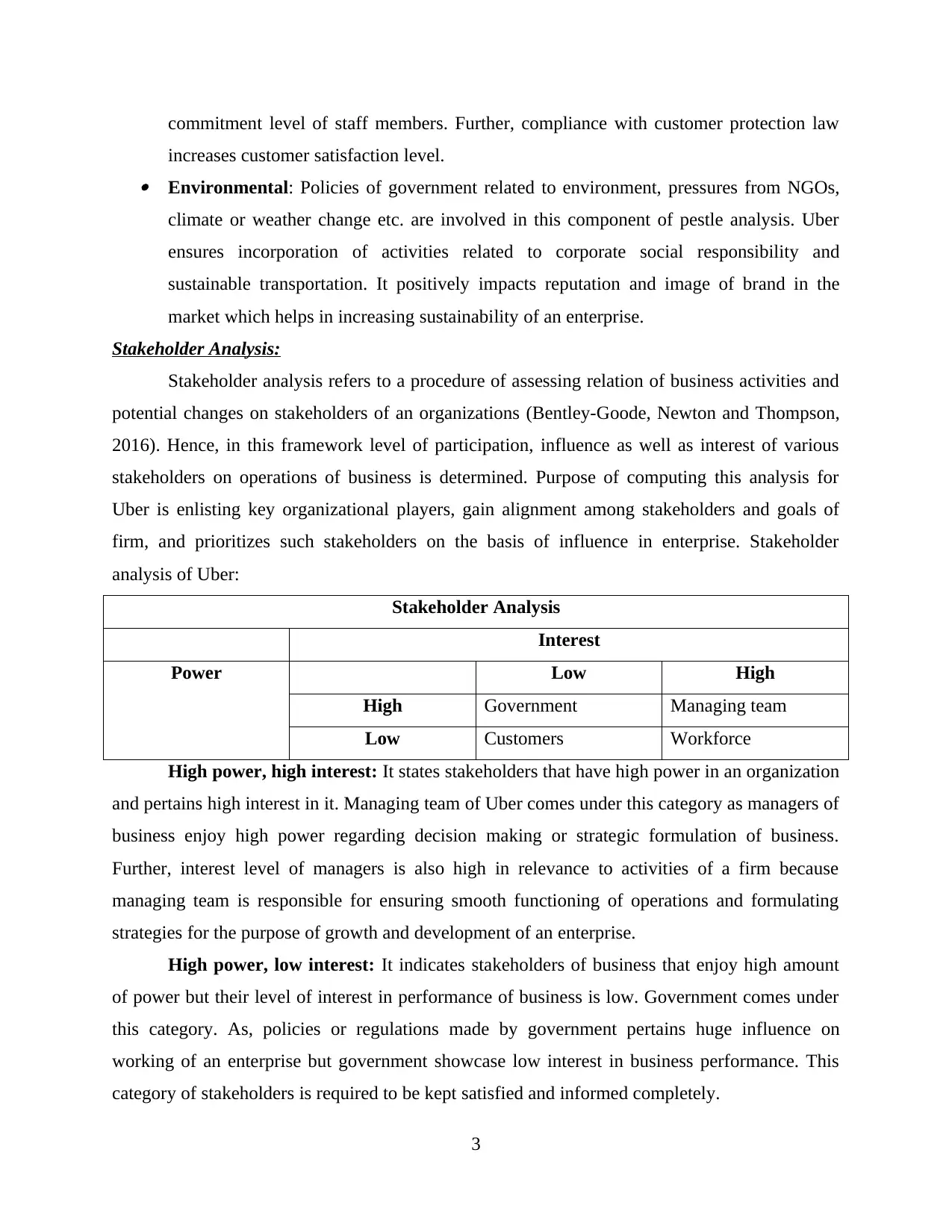
commitment level of staff members. Further, compliance with customer protection law
increases customer satisfaction level. Environmental: Policies of government related to environment, pressures from NGOs,
climate or weather change etc. are involved in this component of pestle analysis. Uber
ensures incorporation of activities related to corporate social responsibility and
sustainable transportation. It positively impacts reputation and image of brand in the
market which helps in increasing sustainability of an enterprise.
Stakeholder Analysis:
Stakeholder analysis refers to a procedure of assessing relation of business activities and
potential changes on stakeholders of an organizations (Bentley-Goode, Newton and Thompson,
2016). Hence, in this framework level of participation, influence as well as interest of various
stakeholders on operations of business is determined. Purpose of computing this analysis for
Uber is enlisting key organizational players, gain alignment among stakeholders and goals of
firm, and prioritizes such stakeholders on the basis of influence in enterprise. Stakeholder
analysis of Uber:
Stakeholder Analysis
Interest
Power Low High
High Government Managing team
Low Customers Workforce
High power, high interest: It states stakeholders that have high power in an organization
and pertains high interest in it. Managing team of Uber comes under this category as managers of
business enjoy high power regarding decision making or strategic formulation of business.
Further, interest level of managers is also high in relevance to activities of a firm because
managing team is responsible for ensuring smooth functioning of operations and formulating
strategies for the purpose of growth and development of an enterprise.
High power, low interest: It indicates stakeholders of business that enjoy high amount
of power but their level of interest in performance of business is low. Government comes under
this category. As, policies or regulations made by government pertains huge influence on
working of an enterprise but government showcase low interest in business performance. This
category of stakeholders is required to be kept satisfied and informed completely.
3
increases customer satisfaction level. Environmental: Policies of government related to environment, pressures from NGOs,
climate or weather change etc. are involved in this component of pestle analysis. Uber
ensures incorporation of activities related to corporate social responsibility and
sustainable transportation. It positively impacts reputation and image of brand in the
market which helps in increasing sustainability of an enterprise.
Stakeholder Analysis:
Stakeholder analysis refers to a procedure of assessing relation of business activities and
potential changes on stakeholders of an organizations (Bentley-Goode, Newton and Thompson,
2016). Hence, in this framework level of participation, influence as well as interest of various
stakeholders on operations of business is determined. Purpose of computing this analysis for
Uber is enlisting key organizational players, gain alignment among stakeholders and goals of
firm, and prioritizes such stakeholders on the basis of influence in enterprise. Stakeholder
analysis of Uber:
Stakeholder Analysis
Interest
Power Low High
High Government Managing team
Low Customers Workforce
High power, high interest: It states stakeholders that have high power in an organization
and pertains high interest in it. Managing team of Uber comes under this category as managers of
business enjoy high power regarding decision making or strategic formulation of business.
Further, interest level of managers is also high in relevance to activities of a firm because
managing team is responsible for ensuring smooth functioning of operations and formulating
strategies for the purpose of growth and development of an enterprise.
High power, low interest: It indicates stakeholders of business that enjoy high amount
of power but their level of interest in performance of business is low. Government comes under
this category. As, policies or regulations made by government pertains huge influence on
working of an enterprise but government showcase low interest in business performance. This
category of stakeholders is required to be kept satisfied and informed completely.
3
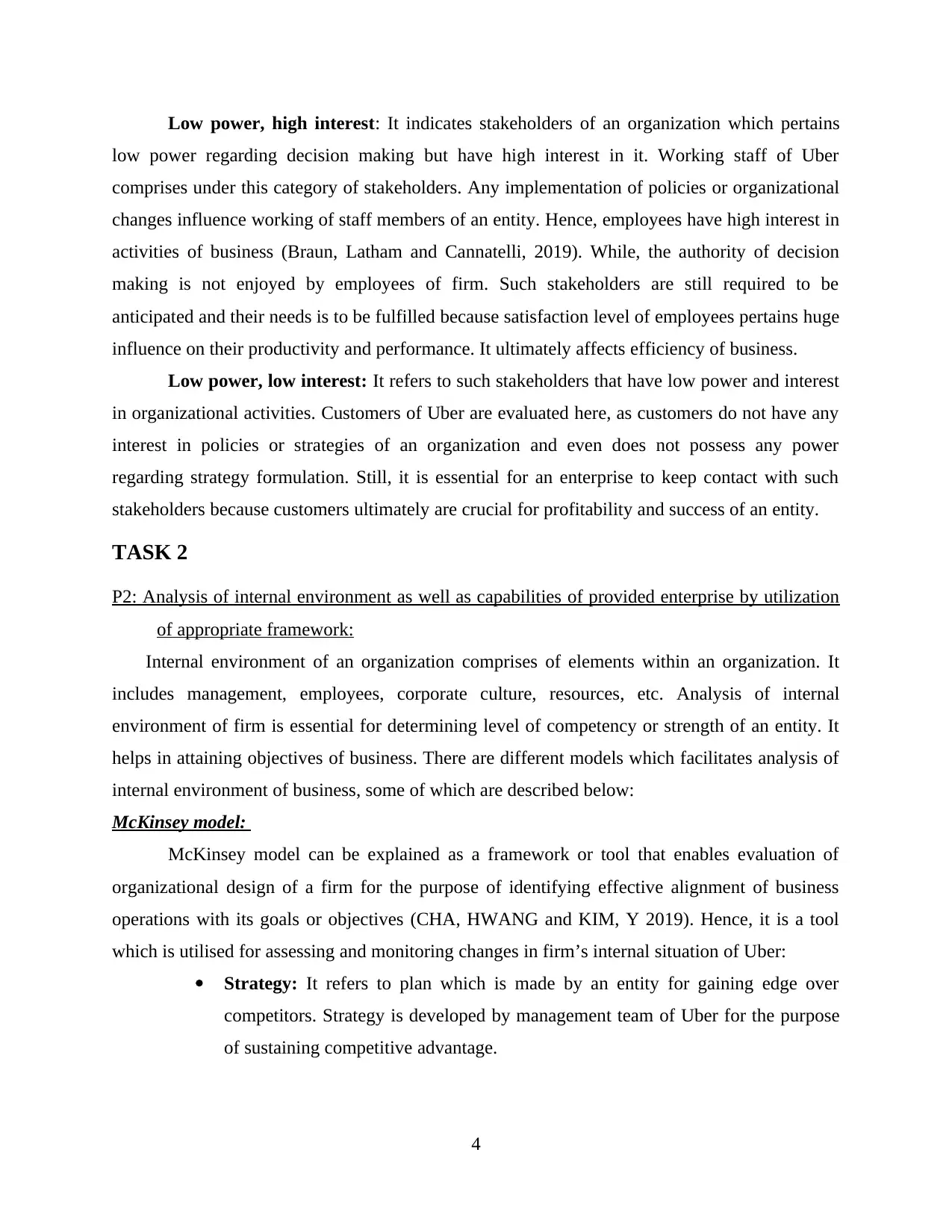
Low power, high interest: It indicates stakeholders of an organization which pertains
low power regarding decision making but have high interest in it. Working staff of Uber
comprises under this category of stakeholders. Any implementation of policies or organizational
changes influence working of staff members of an entity. Hence, employees have high interest in
activities of business (Braun, Latham and Cannatelli, 2019). While, the authority of decision
making is not enjoyed by employees of firm. Such stakeholders are still required to be
anticipated and their needs is to be fulfilled because satisfaction level of employees pertains huge
influence on their productivity and performance. It ultimately affects efficiency of business.
Low power, low interest: It refers to such stakeholders that have low power and interest
in organizational activities. Customers of Uber are evaluated here, as customers do not have any
interest in policies or strategies of an organization and even does not possess any power
regarding strategy formulation. Still, it is essential for an enterprise to keep contact with such
stakeholders because customers ultimately are crucial for profitability and success of an entity.
TASK 2
P2: Analysis of internal environment as well as capabilities of provided enterprise by utilization
of appropriate framework:
Internal environment of an organization comprises of elements within an organization. It
includes management, employees, corporate culture, resources, etc. Analysis of internal
environment of firm is essential for determining level of competency or strength of an entity. It
helps in attaining objectives of business. There are different models which facilitates analysis of
internal environment of business, some of which are described below:
McKinsey model:
McKinsey model can be explained as a framework or tool that enables evaluation of
organizational design of a firm for the purpose of identifying effective alignment of business
operations with its goals or objectives (CHA, HWANG and KIM, Y 2019). Hence, it is a tool
which is utilised for assessing and monitoring changes in firm’s internal situation of Uber:
Strategy: It refers to plan which is made by an entity for gaining edge over
competitors. Strategy is developed by management team of Uber for the purpose
of sustaining competitive advantage.
4
low power regarding decision making but have high interest in it. Working staff of Uber
comprises under this category of stakeholders. Any implementation of policies or organizational
changes influence working of staff members of an entity. Hence, employees have high interest in
activities of business (Braun, Latham and Cannatelli, 2019). While, the authority of decision
making is not enjoyed by employees of firm. Such stakeholders are still required to be
anticipated and their needs is to be fulfilled because satisfaction level of employees pertains huge
influence on their productivity and performance. It ultimately affects efficiency of business.
Low power, low interest: It refers to such stakeholders that have low power and interest
in organizational activities. Customers of Uber are evaluated here, as customers do not have any
interest in policies or strategies of an organization and even does not possess any power
regarding strategy formulation. Still, it is essential for an enterprise to keep contact with such
stakeholders because customers ultimately are crucial for profitability and success of an entity.
TASK 2
P2: Analysis of internal environment as well as capabilities of provided enterprise by utilization
of appropriate framework:
Internal environment of an organization comprises of elements within an organization. It
includes management, employees, corporate culture, resources, etc. Analysis of internal
environment of firm is essential for determining level of competency or strength of an entity. It
helps in attaining objectives of business. There are different models which facilitates analysis of
internal environment of business, some of which are described below:
McKinsey model:
McKinsey model can be explained as a framework or tool that enables evaluation of
organizational design of a firm for the purpose of identifying effective alignment of business
operations with its goals or objectives (CHA, HWANG and KIM, Y 2019). Hence, it is a tool
which is utilised for assessing and monitoring changes in firm’s internal situation of Uber:
Strategy: It refers to plan which is made by an entity for gaining edge over
competitors. Strategy is developed by management team of Uber for the purpose
of sustaining competitive advantage.
4
⊘ This is a preview!⊘
Do you want full access?
Subscribe today to unlock all pages.

Trusted by 1+ million students worldwide
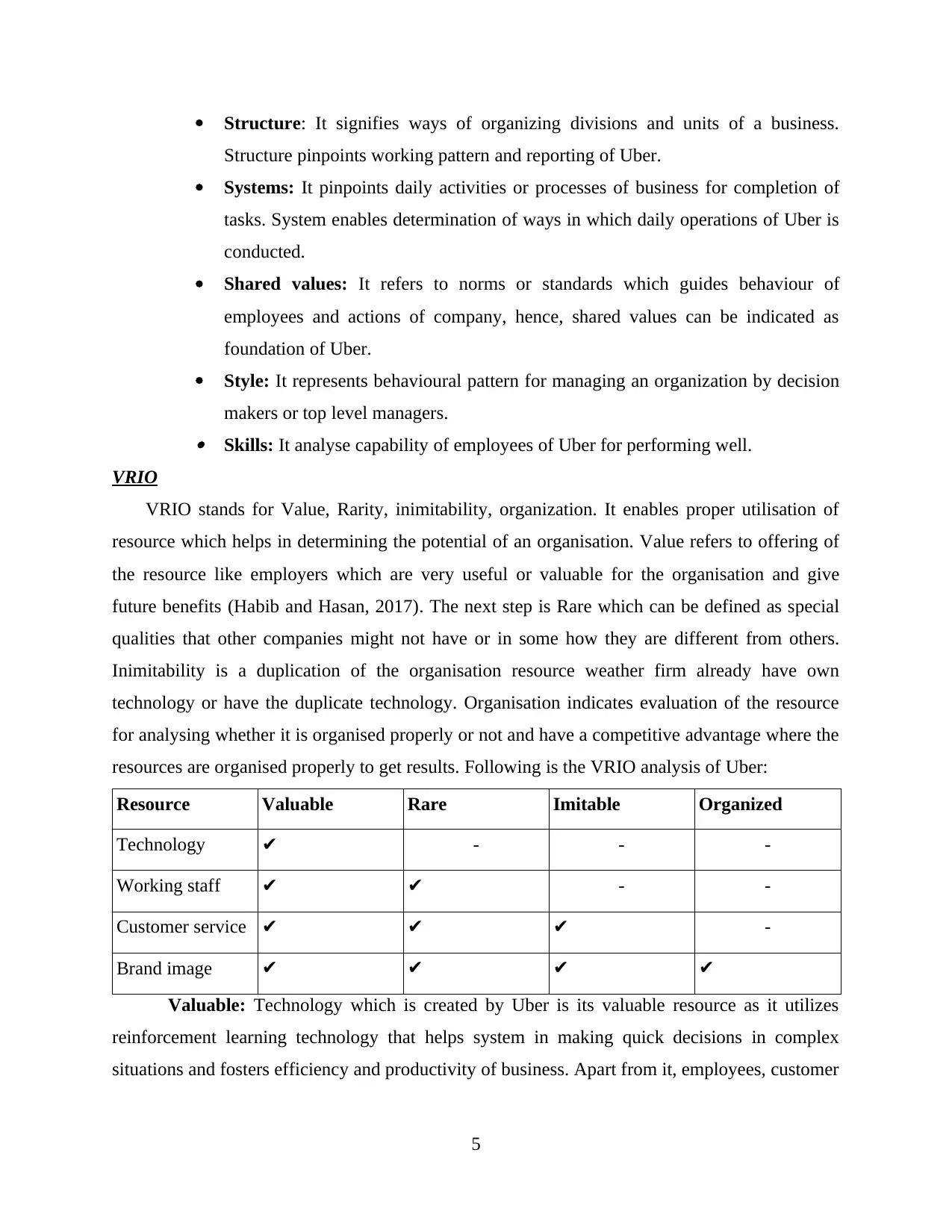
Structure: It signifies ways of organizing divisions and units of a business.
Structure pinpoints working pattern and reporting of Uber.
Systems: It pinpoints daily activities or processes of business for completion of
tasks. System enables determination of ways in which daily operations of Uber is
conducted.
Shared values: It refers to norms or standards which guides behaviour of
employees and actions of company, hence, shared values can be indicated as
foundation of Uber.
Style: It represents behavioural pattern for managing an organization by decision
makers or top level managers.
Skills: It analyse capability of employees of Uber for performing well.
VRIO
VRIO stands for Value, Rarity, inimitability, organization. It enables proper utilisation of
resource which helps in determining the potential of an organisation. Value refers to offering of
the resource like employers which are very useful or valuable for the organisation and give
future benefits (Habib and Hasan, 2017). The next step is Rare which can be defined as special
qualities that other companies might not have or in some how they are different from others.
Inimitability is a duplication of the organisation resource weather firm already have own
technology or have the duplicate technology. Organisation indicates evaluation of the resource
for analysing whether it is organised properly or not and have a competitive advantage where the
resources are organised properly to get results. Following is the VRIO analysis of Uber:
Resource Valuable Rare Imitable Organized
Technology ✔ - - -
Working staff ✔ ✔ - -
Customer service ✔ ✔ ✔ -
Brand image ✔ ✔ ✔ ✔
Valuable: Technology which is created by Uber is its valuable resource as it utilizes
reinforcement learning technology that helps system in making quick decisions in complex
situations and fosters efficiency and productivity of business. Apart from it, employees, customer
5
Structure pinpoints working pattern and reporting of Uber.
Systems: It pinpoints daily activities or processes of business for completion of
tasks. System enables determination of ways in which daily operations of Uber is
conducted.
Shared values: It refers to norms or standards which guides behaviour of
employees and actions of company, hence, shared values can be indicated as
foundation of Uber.
Style: It represents behavioural pattern for managing an organization by decision
makers or top level managers.
Skills: It analyse capability of employees of Uber for performing well.
VRIO
VRIO stands for Value, Rarity, inimitability, organization. It enables proper utilisation of
resource which helps in determining the potential of an organisation. Value refers to offering of
the resource like employers which are very useful or valuable for the organisation and give
future benefits (Habib and Hasan, 2017). The next step is Rare which can be defined as special
qualities that other companies might not have or in some how they are different from others.
Inimitability is a duplication of the organisation resource weather firm already have own
technology or have the duplicate technology. Organisation indicates evaluation of the resource
for analysing whether it is organised properly or not and have a competitive advantage where the
resources are organised properly to get results. Following is the VRIO analysis of Uber:
Resource Valuable Rare Imitable Organized
Technology ✔ - - -
Working staff ✔ ✔ - -
Customer service ✔ ✔ ✔ -
Brand image ✔ ✔ ✔ ✔
Valuable: Technology which is created by Uber is its valuable resource as it utilizes
reinforcement learning technology that helps system in making quick decisions in complex
situations and fosters efficiency and productivity of business. Apart from it, employees, customer
5
Paraphrase This Document
Need a fresh take? Get an instant paraphrase of this document with our AI Paraphraser
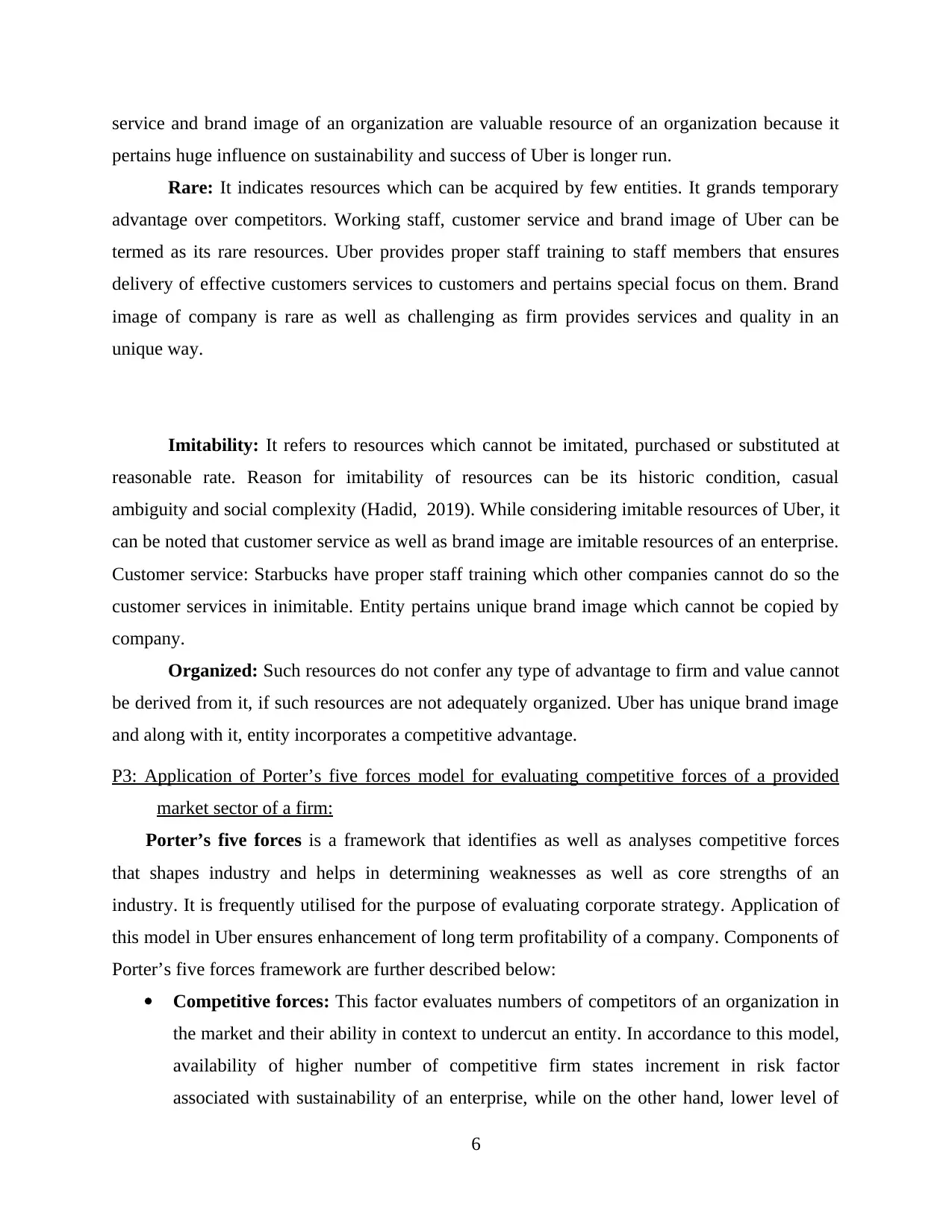
service and brand image of an organization are valuable resource of an organization because it
pertains huge influence on sustainability and success of Uber is longer run.
Rare: It indicates resources which can be acquired by few entities. It grands temporary
advantage over competitors. Working staff, customer service and brand image of Uber can be
termed as its rare resources. Uber provides proper staff training to staff members that ensures
delivery of effective customers services to customers and pertains special focus on them. Brand
image of company is rare as well as challenging as firm provides services and quality in an
unique way.
Imitability: It refers to resources which cannot be imitated, purchased or substituted at
reasonable rate. Reason for imitability of resources can be its historic condition, casual
ambiguity and social complexity (Hadid, 2019). While considering imitable resources of Uber, it
can be noted that customer service as well as brand image are imitable resources of an enterprise.
Customer service: Starbucks have proper staff training which other companies cannot do so the
customer services in inimitable. Entity pertains unique brand image which cannot be copied by
company.
Organized: Such resources do not confer any type of advantage to firm and value cannot
be derived from it, if such resources are not adequately organized. Uber has unique brand image
and along with it, entity incorporates a competitive advantage.
P3: Application of Porter’s five forces model for evaluating competitive forces of a provided
market sector of a firm:
Porter’s five forces is a framework that identifies as well as analyses competitive forces
that shapes industry and helps in determining weaknesses as well as core strengths of an
industry. It is frequently utilised for the purpose of evaluating corporate strategy. Application of
this model in Uber ensures enhancement of long term profitability of a company. Components of
Porter’s five forces framework are further described below:
Competitive forces: This factor evaluates numbers of competitors of an organization in
the market and their ability in context to undercut an entity. In accordance to this model,
availability of higher number of competitive firm states increment in risk factor
associated with sustainability of an enterprise, while on the other hand, lower level of
6
pertains huge influence on sustainability and success of Uber is longer run.
Rare: It indicates resources which can be acquired by few entities. It grands temporary
advantage over competitors. Working staff, customer service and brand image of Uber can be
termed as its rare resources. Uber provides proper staff training to staff members that ensures
delivery of effective customers services to customers and pertains special focus on them. Brand
image of company is rare as well as challenging as firm provides services and quality in an
unique way.
Imitability: It refers to resources which cannot be imitated, purchased or substituted at
reasonable rate. Reason for imitability of resources can be its historic condition, casual
ambiguity and social complexity (Hadid, 2019). While considering imitable resources of Uber, it
can be noted that customer service as well as brand image are imitable resources of an enterprise.
Customer service: Starbucks have proper staff training which other companies cannot do so the
customer services in inimitable. Entity pertains unique brand image which cannot be copied by
company.
Organized: Such resources do not confer any type of advantage to firm and value cannot
be derived from it, if such resources are not adequately organized. Uber has unique brand image
and along with it, entity incorporates a competitive advantage.
P3: Application of Porter’s five forces model for evaluating competitive forces of a provided
market sector of a firm:
Porter’s five forces is a framework that identifies as well as analyses competitive forces
that shapes industry and helps in determining weaknesses as well as core strengths of an
industry. It is frequently utilised for the purpose of evaluating corporate strategy. Application of
this model in Uber ensures enhancement of long term profitability of a company. Components of
Porter’s five forces framework are further described below:
Competitive forces: This factor evaluates numbers of competitors of an organization in
the market and their ability in context to undercut an entity. In accordance to this model,
availability of higher number of competitive firm states increment in risk factor
associated with sustainability of an enterprise, while on the other hand, lower level of
6
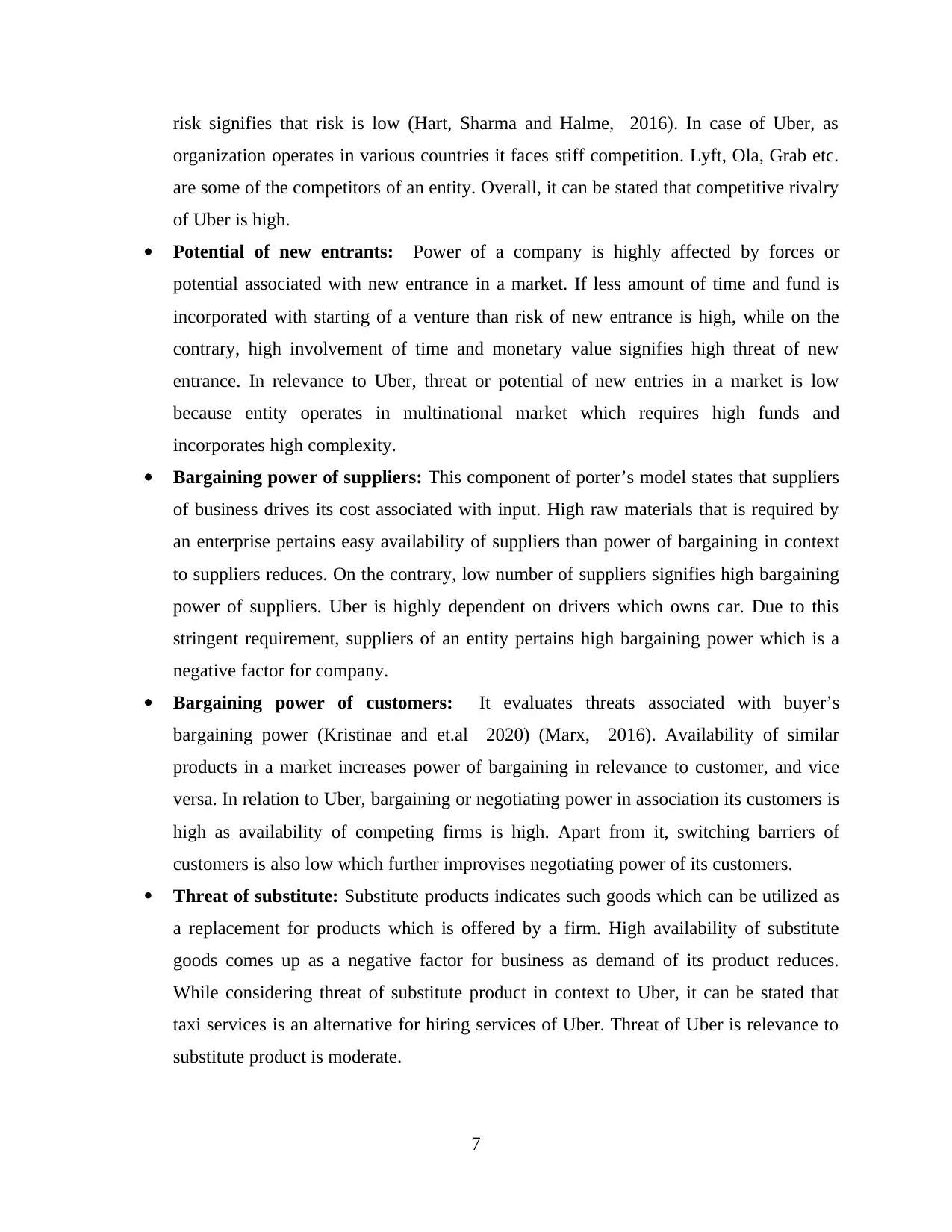
risk signifies that risk is low (Hart, Sharma and Halme, 2016). In case of Uber, as
organization operates in various countries it faces stiff competition. Lyft, Ola, Grab etc.
are some of the competitors of an entity. Overall, it can be stated that competitive rivalry
of Uber is high.
Potential of new entrants: Power of a company is highly affected by forces or
potential associated with new entrance in a market. If less amount of time and fund is
incorporated with starting of a venture than risk of new entrance is high, while on the
contrary, high involvement of time and monetary value signifies high threat of new
entrance. In relevance to Uber, threat or potential of new entries in a market is low
because entity operates in multinational market which requires high funds and
incorporates high complexity.
Bargaining power of suppliers: This component of porter’s model states that suppliers
of business drives its cost associated with input. High raw materials that is required by
an enterprise pertains easy availability of suppliers than power of bargaining in context
to suppliers reduces. On the contrary, low number of suppliers signifies high bargaining
power of suppliers. Uber is highly dependent on drivers which owns car. Due to this
stringent requirement, suppliers of an entity pertains high bargaining power which is a
negative factor for company.
Bargaining power of customers: It evaluates threats associated with buyer’s
bargaining power (Kristinae and et.al 2020) (Marx, 2016). Availability of similar
products in a market increases power of bargaining in relevance to customer, and vice
versa. In relation to Uber, bargaining or negotiating power in association its customers is
high as availability of competing firms is high. Apart from it, switching barriers of
customers is also low which further improvises negotiating power of its customers.
Threat of substitute: Substitute products indicates such goods which can be utilized as
a replacement for products which is offered by a firm. High availability of substitute
goods comes up as a negative factor for business as demand of its product reduces.
While considering threat of substitute product in context to Uber, it can be stated that
taxi services is an alternative for hiring services of Uber. Threat of Uber is relevance to
substitute product is moderate.
7
organization operates in various countries it faces stiff competition. Lyft, Ola, Grab etc.
are some of the competitors of an entity. Overall, it can be stated that competitive rivalry
of Uber is high.
Potential of new entrants: Power of a company is highly affected by forces or
potential associated with new entrance in a market. If less amount of time and fund is
incorporated with starting of a venture than risk of new entrance is high, while on the
contrary, high involvement of time and monetary value signifies high threat of new
entrance. In relevance to Uber, threat or potential of new entries in a market is low
because entity operates in multinational market which requires high funds and
incorporates high complexity.
Bargaining power of suppliers: This component of porter’s model states that suppliers
of business drives its cost associated with input. High raw materials that is required by
an enterprise pertains easy availability of suppliers than power of bargaining in context
to suppliers reduces. On the contrary, low number of suppliers signifies high bargaining
power of suppliers. Uber is highly dependent on drivers which owns car. Due to this
stringent requirement, suppliers of an entity pertains high bargaining power which is a
negative factor for company.
Bargaining power of customers: It evaluates threats associated with buyer’s
bargaining power (Kristinae and et.al 2020) (Marx, 2016). Availability of similar
products in a market increases power of bargaining in relevance to customer, and vice
versa. In relation to Uber, bargaining or negotiating power in association its customers is
high as availability of competing firms is high. Apart from it, switching barriers of
customers is also low which further improvises negotiating power of its customers.
Threat of substitute: Substitute products indicates such goods which can be utilized as
a replacement for products which is offered by a firm. High availability of substitute
goods comes up as a negative factor for business as demand of its product reduces.
While considering threat of substitute product in context to Uber, it can be stated that
taxi services is an alternative for hiring services of Uber. Threat of Uber is relevance to
substitute product is moderate.
7
⊘ This is a preview!⊘
Do you want full access?
Subscribe today to unlock all pages.

Trusted by 1+ million students worldwide
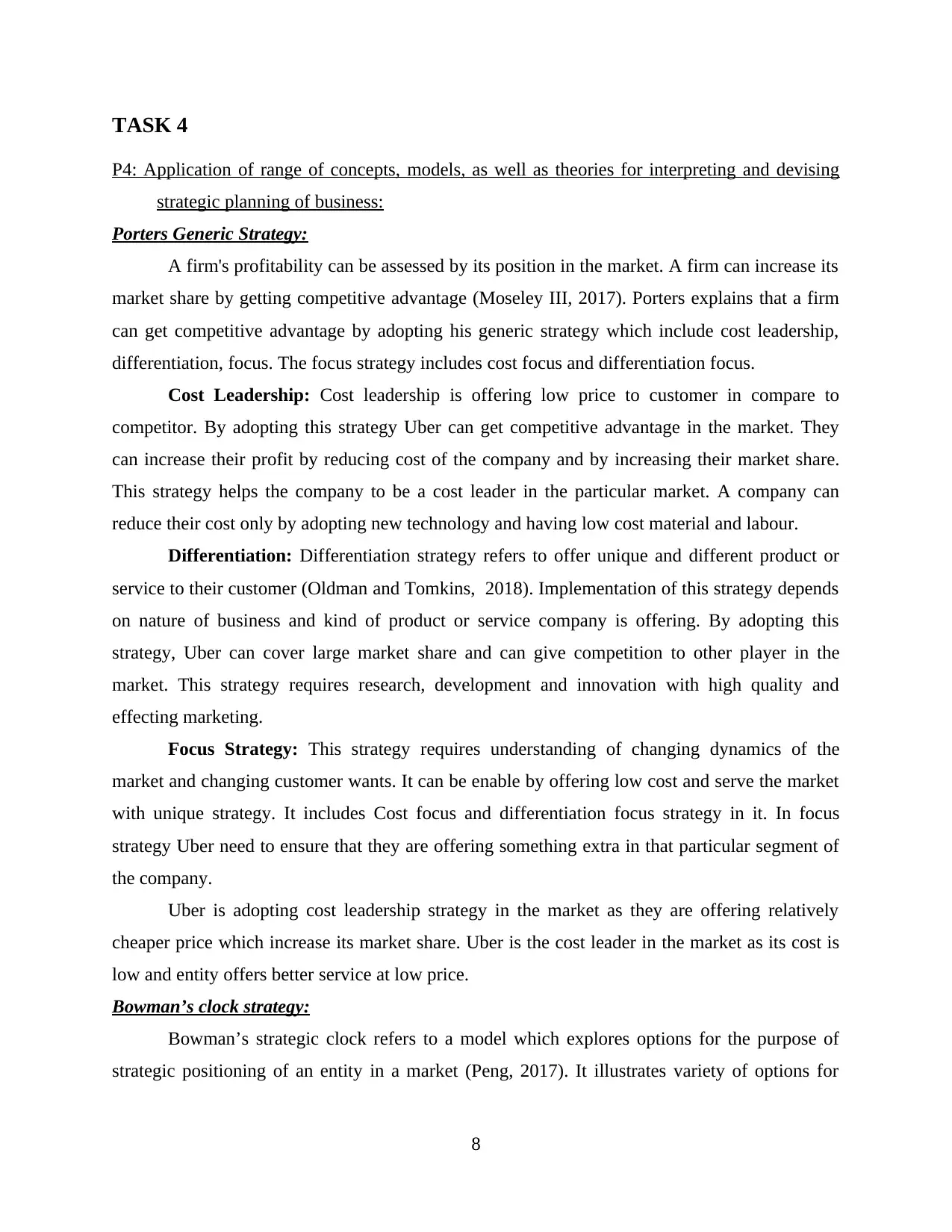
TASK 4
P4: Application of range of concepts, models, as well as theories for interpreting and devising
strategic planning of business:
Porters Generic Strategy:
A firm's profitability can be assessed by its position in the market. A firm can increase its
market share by getting competitive advantage (Moseley III, 2017). Porters explains that a firm
can get competitive advantage by adopting his generic strategy which include cost leadership,
differentiation, focus. The focus strategy includes cost focus and differentiation focus.
Cost Leadership: Cost leadership is offering low price to customer in compare to
competitor. By adopting this strategy Uber can get competitive advantage in the market. They
can increase their profit by reducing cost of the company and by increasing their market share.
This strategy helps the company to be a cost leader in the particular market. A company can
reduce their cost only by adopting new technology and having low cost material and labour.
Differentiation: Differentiation strategy refers to offer unique and different product or
service to their customer (Oldman and Tomkins, 2018). Implementation of this strategy depends
on nature of business and kind of product or service company is offering. By adopting this
strategy, Uber can cover large market share and can give competition to other player in the
market. This strategy requires research, development and innovation with high quality and
effecting marketing.
Focus Strategy: This strategy requires understanding of changing dynamics of the
market and changing customer wants. It can be enable by offering low cost and serve the market
with unique strategy. It includes Cost focus and differentiation focus strategy in it. In focus
strategy Uber need to ensure that they are offering something extra in that particular segment of
the company.
Uber is adopting cost leadership strategy in the market as they are offering relatively
cheaper price which increase its market share. Uber is the cost leader in the market as its cost is
low and entity offers better service at low price.
Bowman’s clock strategy:
Bowman’s strategic clock refers to a model which explores options for the purpose of
strategic positioning of an entity in a market (Peng, 2017). It illustrates variety of options for
8
P4: Application of range of concepts, models, as well as theories for interpreting and devising
strategic planning of business:
Porters Generic Strategy:
A firm's profitability can be assessed by its position in the market. A firm can increase its
market share by getting competitive advantage (Moseley III, 2017). Porters explains that a firm
can get competitive advantage by adopting his generic strategy which include cost leadership,
differentiation, focus. The focus strategy includes cost focus and differentiation focus.
Cost Leadership: Cost leadership is offering low price to customer in compare to
competitor. By adopting this strategy Uber can get competitive advantage in the market. They
can increase their profit by reducing cost of the company and by increasing their market share.
This strategy helps the company to be a cost leader in the particular market. A company can
reduce their cost only by adopting new technology and having low cost material and labour.
Differentiation: Differentiation strategy refers to offer unique and different product or
service to their customer (Oldman and Tomkins, 2018). Implementation of this strategy depends
on nature of business and kind of product or service company is offering. By adopting this
strategy, Uber can cover large market share and can give competition to other player in the
market. This strategy requires research, development and innovation with high quality and
effecting marketing.
Focus Strategy: This strategy requires understanding of changing dynamics of the
market and changing customer wants. It can be enable by offering low cost and serve the market
with unique strategy. It includes Cost focus and differentiation focus strategy in it. In focus
strategy Uber need to ensure that they are offering something extra in that particular segment of
the company.
Uber is adopting cost leadership strategy in the market as they are offering relatively
cheaper price which increase its market share. Uber is the cost leader in the market as its cost is
low and entity offers better service at low price.
Bowman’s clock strategy:
Bowman’s strategic clock refers to a model which explores options for the purpose of
strategic positioning of an entity in a market (Peng, 2017). It illustrates variety of options for
8
Paraphrase This Document
Need a fresh take? Get an instant paraphrase of this document with our AI Paraphraser
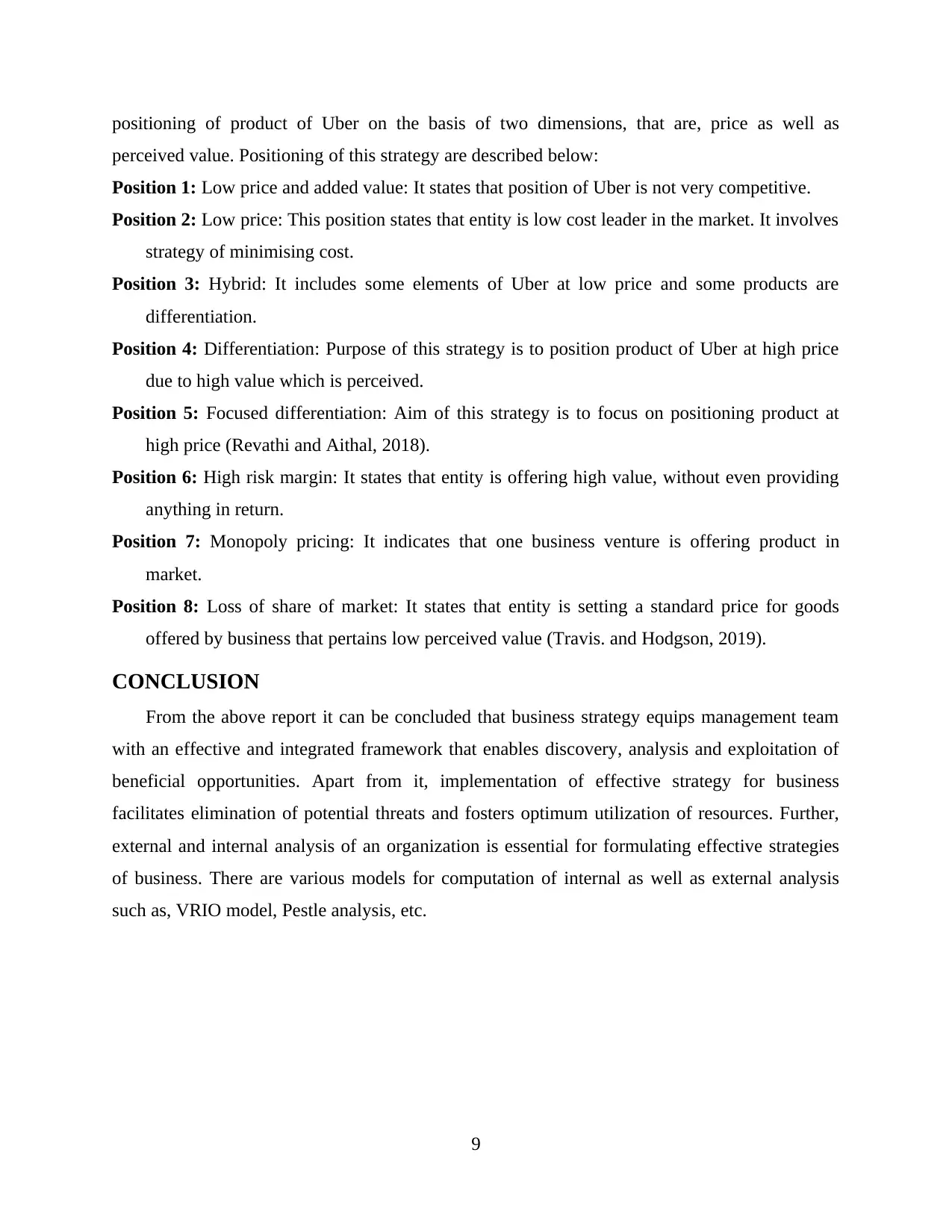
positioning of product of Uber on the basis of two dimensions, that are, price as well as
perceived value. Positioning of this strategy are described below:
Position 1: Low price and added value: It states that position of Uber is not very competitive.
Position 2: Low price: This position states that entity is low cost leader in the market. It involves
strategy of minimising cost.
Position 3: Hybrid: It includes some elements of Uber at low price and some products are
differentiation.
Position 4: Differentiation: Purpose of this strategy is to position product of Uber at high price
due to high value which is perceived.
Position 5: Focused differentiation: Aim of this strategy is to focus on positioning product at
high price (Revathi and Aithal, 2018).
Position 6: High risk margin: It states that entity is offering high value, without even providing
anything in return.
Position 7: Monopoly pricing: It indicates that one business venture is offering product in
market.
Position 8: Loss of share of market: It states that entity is setting a standard price for goods
offered by business that pertains low perceived value (Travis. and Hodgson, 2019).
CONCLUSION
From the above report it can be concluded that business strategy equips management team
with an effective and integrated framework that enables discovery, analysis and exploitation of
beneficial opportunities. Apart from it, implementation of effective strategy for business
facilitates elimination of potential threats and fosters optimum utilization of resources. Further,
external and internal analysis of an organization is essential for formulating effective strategies
of business. There are various models for computation of internal as well as external analysis
such as, VRIO model, Pestle analysis, etc.
9
perceived value. Positioning of this strategy are described below:
Position 1: Low price and added value: It states that position of Uber is not very competitive.
Position 2: Low price: This position states that entity is low cost leader in the market. It involves
strategy of minimising cost.
Position 3: Hybrid: It includes some elements of Uber at low price and some products are
differentiation.
Position 4: Differentiation: Purpose of this strategy is to position product of Uber at high price
due to high value which is perceived.
Position 5: Focused differentiation: Aim of this strategy is to focus on positioning product at
high price (Revathi and Aithal, 2018).
Position 6: High risk margin: It states that entity is offering high value, without even providing
anything in return.
Position 7: Monopoly pricing: It indicates that one business venture is offering product in
market.
Position 8: Loss of share of market: It states that entity is setting a standard price for goods
offered by business that pertains low perceived value (Travis. and Hodgson, 2019).
CONCLUSION
From the above report it can be concluded that business strategy equips management team
with an effective and integrated framework that enables discovery, analysis and exploitation of
beneficial opportunities. Apart from it, implementation of effective strategy for business
facilitates elimination of potential threats and fosters optimum utilization of resources. Further,
external and internal analysis of an organization is essential for formulating effective strategies
of business. There are various models for computation of internal as well as external analysis
such as, VRIO model, Pestle analysis, etc.
9
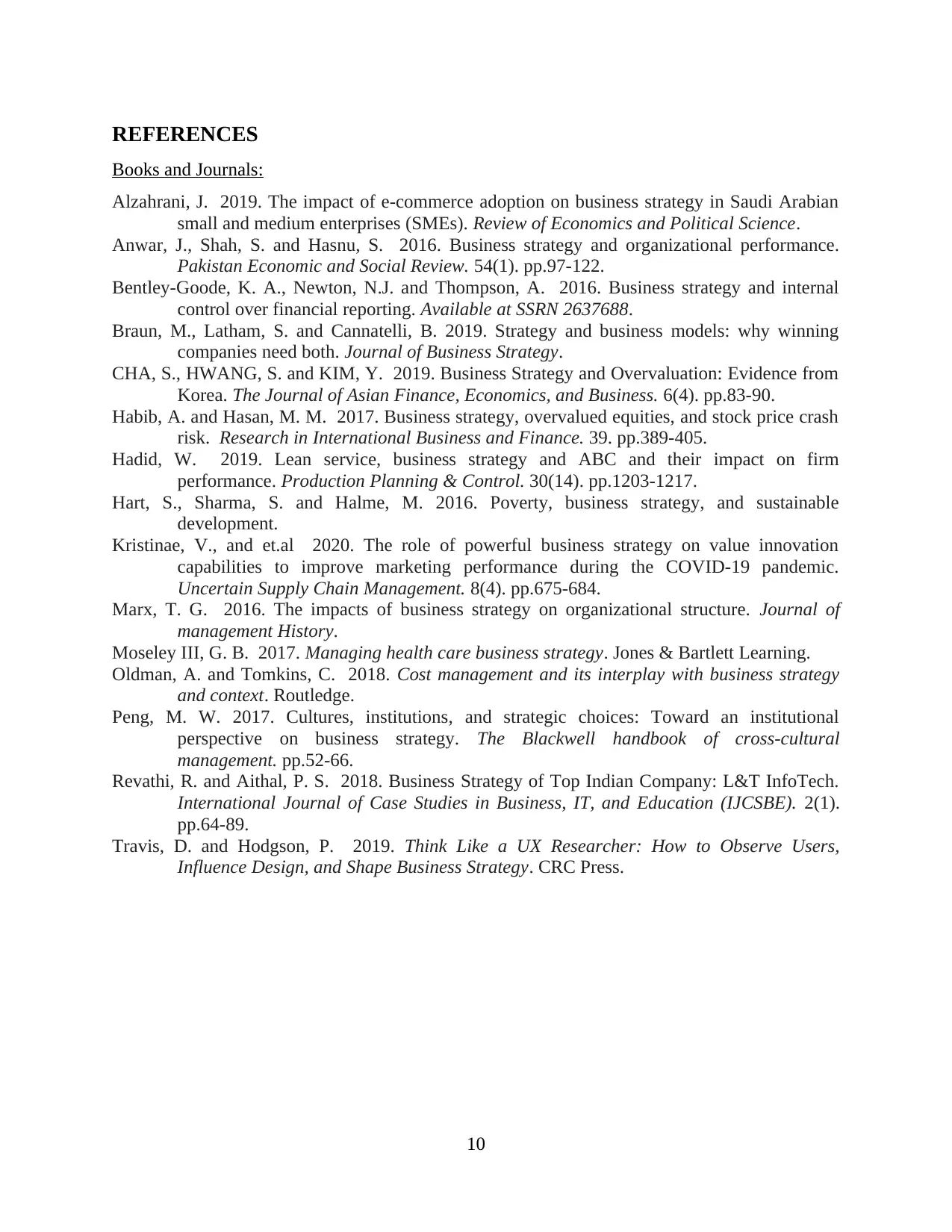
REFERENCES
Books and Journals:
Alzahrani, J. 2019. The impact of e-commerce adoption on business strategy in Saudi Arabian
small and medium enterprises (SMEs). Review of Economics and Political Science.
Anwar, J., Shah, S. and Hasnu, S. 2016. Business strategy and organizational performance.
Pakistan Economic and Social Review. 54(1). pp.97-122.
Bentley-Goode, K. A., Newton, N.J. and Thompson, A. 2016. Business strategy and internal
control over financial reporting. Available at SSRN 2637688.
Braun, M., Latham, S. and Cannatelli, B. 2019. Strategy and business models: why winning
companies need both. Journal of Business Strategy.
CHA, S., HWANG, S. and KIM, Y. 2019. Business Strategy and Overvaluation: Evidence from
Korea. The Journal of Asian Finance, Economics, and Business. 6(4). pp.83-90.
Habib, A. and Hasan, M. M. 2017. Business strategy, overvalued equities, and stock price crash
risk. Research in International Business and Finance. 39. pp.389-405.
Hadid, W. 2019. Lean service, business strategy and ABC and their impact on firm
performance. Production Planning & Control. 30(14). pp.1203-1217.
Hart, S., Sharma, S. and Halme, M. 2016. Poverty, business strategy, and sustainable
development.
Kristinae, V., and et.al 2020. The role of powerful business strategy on value innovation
capabilities to improve marketing performance during the COVID-19 pandemic.
Uncertain Supply Chain Management. 8(4). pp.675-684.
Marx, T. G. 2016. The impacts of business strategy on organizational structure. Journal of
management History.
Moseley III, G. B. 2017. Managing health care business strategy. Jones & Bartlett Learning.
Oldman, A. and Tomkins, C. 2018. Cost management and its interplay with business strategy
and context. Routledge.
Peng, M. W. 2017. Cultures, institutions, and strategic choices: Toward an institutional
perspective on business strategy. The Blackwell handbook of cross‐cultural
management. pp.52-66.
Revathi, R. and Aithal, P. S. 2018. Business Strategy of Top Indian Company: L&T InfoTech.
International Journal of Case Studies in Business, IT, and Education (IJCSBE). 2(1).
pp.64-89.
Travis, D. and Hodgson, P. 2019. Think Like a UX Researcher: How to Observe Users,
Influence Design, and Shape Business Strategy. CRC Press.
10
Books and Journals:
Alzahrani, J. 2019. The impact of e-commerce adoption on business strategy in Saudi Arabian
small and medium enterprises (SMEs). Review of Economics and Political Science.
Anwar, J., Shah, S. and Hasnu, S. 2016. Business strategy and organizational performance.
Pakistan Economic and Social Review. 54(1). pp.97-122.
Bentley-Goode, K. A., Newton, N.J. and Thompson, A. 2016. Business strategy and internal
control over financial reporting. Available at SSRN 2637688.
Braun, M., Latham, S. and Cannatelli, B. 2019. Strategy and business models: why winning
companies need both. Journal of Business Strategy.
CHA, S., HWANG, S. and KIM, Y. 2019. Business Strategy and Overvaluation: Evidence from
Korea. The Journal of Asian Finance, Economics, and Business. 6(4). pp.83-90.
Habib, A. and Hasan, M. M. 2017. Business strategy, overvalued equities, and stock price crash
risk. Research in International Business and Finance. 39. pp.389-405.
Hadid, W. 2019. Lean service, business strategy and ABC and their impact on firm
performance. Production Planning & Control. 30(14). pp.1203-1217.
Hart, S., Sharma, S. and Halme, M. 2016. Poverty, business strategy, and sustainable
development.
Kristinae, V., and et.al 2020. The role of powerful business strategy on value innovation
capabilities to improve marketing performance during the COVID-19 pandemic.
Uncertain Supply Chain Management. 8(4). pp.675-684.
Marx, T. G. 2016. The impacts of business strategy on organizational structure. Journal of
management History.
Moseley III, G. B. 2017. Managing health care business strategy. Jones & Bartlett Learning.
Oldman, A. and Tomkins, C. 2018. Cost management and its interplay with business strategy
and context. Routledge.
Peng, M. W. 2017. Cultures, institutions, and strategic choices: Toward an institutional
perspective on business strategy. The Blackwell handbook of cross‐cultural
management. pp.52-66.
Revathi, R. and Aithal, P. S. 2018. Business Strategy of Top Indian Company: L&T InfoTech.
International Journal of Case Studies in Business, IT, and Education (IJCSBE). 2(1).
pp.64-89.
Travis, D. and Hodgson, P. 2019. Think Like a UX Researcher: How to Observe Users,
Influence Design, and Shape Business Strategy. CRC Press.
10
⊘ This is a preview!⊘
Do you want full access?
Subscribe today to unlock all pages.

Trusted by 1+ million students worldwide
1 out of 13
Related Documents
Your All-in-One AI-Powered Toolkit for Academic Success.
+13062052269
info@desklib.com
Available 24*7 on WhatsApp / Email
![[object Object]](/_next/static/media/star-bottom.7253800d.svg)
Unlock your academic potential
Copyright © 2020–2025 A2Z Services. All Rights Reserved. Developed and managed by ZUCOL.





